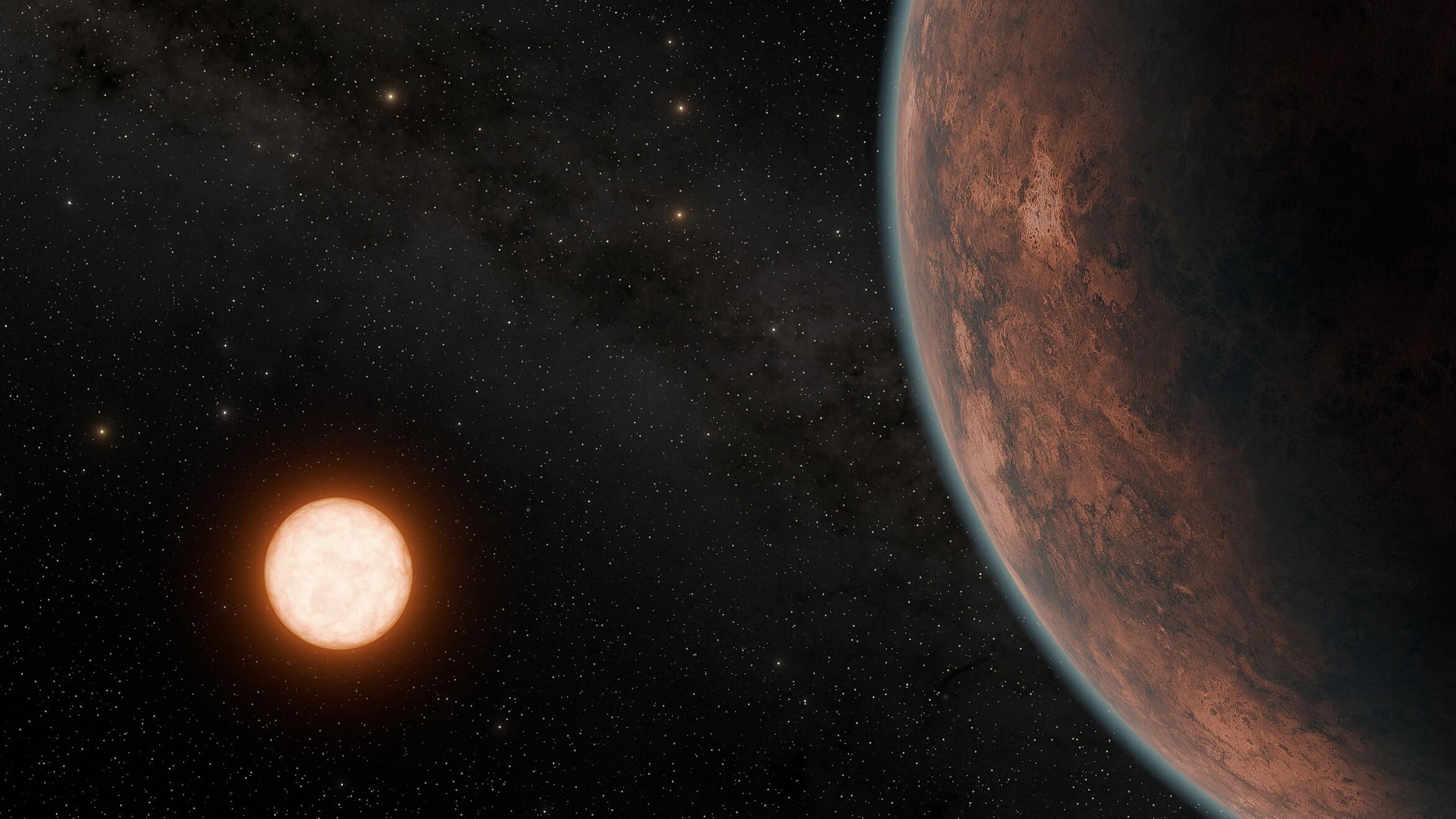 Faith & Science
Faith & Science
 Physics, Earth & Space
Physics, Earth & Space
Interstellar Travel: Fantasy or Destiny?

Reporting on any newly discovered exoplanet, especially if it has even the barest overlap of Earth-like parameters, is standard fare for science news outlets. While these discoveries are exciting from an astronomical point of view, the attention-getting angle often relies upon the presumption that such planets may offer a future home for humans. The notion of extraterrestrial life pullulating on any planetary surface either not hellishly hot or stuck in the frozen outer regions of a distant star system also tends to feed the interest in such reporting.
For example, a recent article at Science News reports, “Potentially Habitable Earth-Sized Exoplanet Discovered Around Gliese 12.” It describes the discovery of a planet orbiting an M-type dwarf star located about 40 light years (lyrs) from Earth. The planet, tagged Gliese 12b (pictured above, according to an artist’s rendering), is so close to its host star that its complete orbit takes only 12.76 days. For a planet orbiting one of these common dwarf stars, several obstacles to habitability prevail, including tidal locking.
However, the tidal force that a star exerts on such closely orbiting planets is extreme. A planet orbiting an M dwarf close enough to possibly possess surface liquid water will be tidally locked, with one of its hemispheres always facing its star (just as one hemisphere of the Moon always faces Earth).
An Alluring Hope
What about the alluring hope of future generations of humans traveling across the interstellar oceans of space to establish Earth outposts on such extrasolar planets? Astronomers have determined the number of possible stellar destinations in our “close” galactic neighborhood. There are roughly 2,000 stars within 50 lyrs of Earth, compared to approximately 200 billion stars in the Milky Way galaxy (one millionth of one percent lie within 50 lyrs of Earth). We can set some boundaries on the feasibility of interstellar space travel (either for humans or putative aliens) by applying the known laws of physics.
Using special relativity, let’s imagine what it would take in terms of raw energy to accelerate a spaceship to the speed necessary to make a 40 lyr journey (say to Gliese 12b) in 5 years as measured by the astronauts onboard. First, we need to find the speed, relative to Earth that this spaceship would have to attain to generate the proper time dilation for the astronauts to arrive in 5 years by their clocks. A bit of algebra with Einstein’s time dilation formula yields a required speed of 0.99c, where c=300,000 km/sec is the speed of light through vacuum.
Since time flows at different rates for the reference frame of Earth compared to the reference frame of the spaceship moving at 0.99c, we find that the journey which takes 5 years for the astronauts takes 40.3 years according to observers back on Earth. This would be somewhat inconvenient, but perhaps manageable. But when we calculate the energy required to accelerate a modest-sized spacecraft, outfitted with everything that a team of astronauts would need for a multi-year expedition to explore an unknown destination, we find that the answer is daunting.
Using Einstein’s special relativity formula for kinetic energy, and assuming a mass for the spaceship equivalent to that of a fully loaded 747 aircraft (m=400,000 kg), we find that the energy needed to accelerate the spaceship to the cruising velocity of 0.99c is 70 quadrillion kWh. Assuming that the astronauts want to stop at the distant star system, we’ll need to double this amount to account for deceleration, for the spaceship to make the one-way journey from Earth to the distant star.
So, just how much energy is 140 quadrillion kWh? Believe it or not, it’s equivalent to 4,800 times the total energy consumption of the United States in the year 2022. This means all the electricity, petroleum, natural gas, and any other form of energy used to power everything in the U.S. for one year would be 4,800 times too small to get our modest-sized spaceship to a relatively nearby star in a reasonable amount of time. I think it’s fair to say that interstellar space travel isn’t even remotely possible with our current understanding of physics and technology.
But Why Not Dream?!
What would we need to trim this daunting energy requirement down to size? Reducing the mass of the spaceship doesn’t exactly solve the problem. Suppose we trade our 747-sized spacecraft for an economy model about the size of a Winnebago camper trailer, having a much smaller mass of 4,500 kg. That’s 89 times less mass than the original spacecraft. Unfortunately, this means that the energy required to get there is still 54 times the total U.S. energy consumption for an entire year.
OK, so we just need a lot of energy, and apparently nothing we currently use for generating energy will come even close to meeting our needs for interstellar space travel. But what’s to say we couldn’t develop a super-charged energy supply? The gold standard for producing energy from mass comes from the total annihilation of matter, converting it 100 percent to energy according to Einstein’s famous equation, E=mc2. How much mass, then, would we need to convert to pure energy to meet our original estimate of 140 quadrillion kWh? The answer turns out to be a little over 5.6 million kg of matter. That’s about 14 times more mass than the mass of the fully-loaded 747-sized spacecraft.
Now it becomes more complicated, but we’d definitely end up needing more than just the 5.6 million kg of matter to convert to energy, since the extra matter that has to be carried along as fuel for the spaceship would require even more energy to accelerate. A rough estimate suggests that the mass of the fuel needed to accelerate the spaceship plus the fuel would be closer to 1,400 times the original mass of the spaceship. This begins to appear impractical, but maybe not impossible.
However, since according to known physics, the only way to accomplish the conversion of matter to pure energy is to combine it with an equal amount of antimatter, our space travelers would also need to carry an equal amount of antimatter. Although a better solution would be to find a way to easily convert matter to antimatter, that can’t be done, directly. In conclusion, accelerating matter to move through space at high speeds is prohibitively energy intensive.
Moving with Space?
Perhaps instead of trying to move through space, one could find a way to move with space. Here, we draw upon results from Einstein’s theory of general relativity. In this model, space itself flows into masses at a speed that is proportional to the strength of the gravitational field around the mass. In the extreme limit of a black hole, the flow rate of space into the black hole becomes equal to the speed of light, as one approaches the boundary around the hole known as the event horizon. Since nothing can move through space faster than the speed of light, this is why there’s no way anything can ever escape from inside the event horizon of a black hole.
How could we use the flow of space for space travel? One useful concept is that we could do so by falling into a black hole; that is, by flowing with space towards the event horizon of the black hole, you could attain movement at the speed of light without expending any external energy. Now, falling into a black hole is a one-way “down the drain” experience, but physicists have mathematically explored the concept of a wormhole, a theoretical construct of spacetime that connects two disparate points in spacetime. Under certain conditions, it is theorized that matter could traverse a wormhole and effectively take a shortcut through hyperspace to facilitate travel to a distant point in the universe (or even into another universe!). However, while serving their purpose as plot props for science fiction stories, wormholes remain distantly removed from scientific reality.
First of all, even with the many existing descriptions of constructions of traversable wormholes, we are nowhere close to actually creating one, or at least to imagining an experiment which would, once put into practice, bring into existence such an object. Moreover, no wormholes have been observed so far in the Universe.
Borrowing from the imagination of science fiction, one of the more intriguing possibilities for interstellar travel involves nullifying the inertia of the entire spaceship. From a physics perspective, we have no idea how this could be done, but if it could, and if relativistic limitations somehow didn’t apply, the result would be marvelous. With the inertialess spaceship having effectively zero mass, its cruising speed would only be limited by the balance between its rocket thrust and the friction the spaceship encounters as it moves through the near-vacuum of the interstellar medium. In the science fiction series utilizing this creative technology, the science-literate author estimated that the touring speed of a spaceship would be about 300 light-years per hour. In this fictional world, a trip to Gliese 12b from Earth would take only about 8 minutes!
Children of Light
The dream of interstellar space travel suffers from a reality check according to the physics we know due to the nearly unfathomable distances separating us from other stars. To put it in perspective, the farthest distance humans have traveled from Earth is to the moon. The distance to our own sun is 400 times farther than to the moon, and the distance to a star system 40 light years away is over 2.5 million times farther away than our sun!
The human yearning to explore finds it hard to accept that travelling to the stars may be physically impossible. But viewing the heavens beyond our reach causes us to look up and stretch our imaginations to envision a realm vastly greater than our own. Travel to the stars may intrigue and fascinate us because we were originally created for a destiny that included accessing this realm.
In the biblical narrative, God is Spirit and light, and in him we are called “children of light” (Ephesians 5:8). To do the impossible may require that we ourselves become beings of light. Light needs no outside energy source to travel between stars, and in the time frame of reference of light, no time is needed to make the trip, even from one side of the universe to the other!

